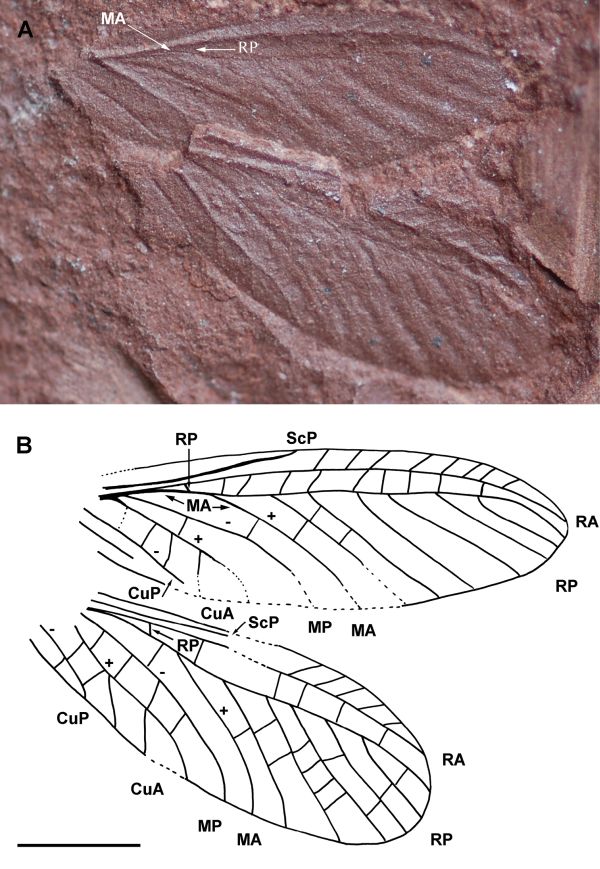
| Palaeos |  |
Palaeodictyopteroida |
| Arthropoda | Diaphanopterodea |
| Page Back: Permothemistida | Unit Up: Arthropoda | Unit Home | Clade Up: Palaeodictyopteroida | Page Next: Dendrogram |
| Unit Back: Pterygota | Clade Down: None | Dendrogram | References | Unit Next: Ephemeroptera |
|
Abbreviated Dendrogram
PTERYGOTA |--Ephemeroptera |--Odonatoptera |--NEOPTERA | `--PALAEODICTYOPTEROIDA |--Palaeodictyoptera `--+--Megasecoptera `--+--Permothemistida `--Diaphanopterodea |
Contents
Overview |
Taxa on This Page
 Alexrasnitsynia permiana (Diaphanopterodea: Alexrasnitsyniidae), from the Middle Permian (Guadalupian) of Salagou Formation in the Lodève Basin (South of France), A photograph of wings, B drawing of wings (Scale bar represents 3 mm). From Prokop & Nel 2011, New Middle Permian palaeopteran insects, Creative Commons Attribution . |
This order of paleopterous insects appeared during the Carboniferous but is best known known from the Permian of Russia and North America, and more recently, Europe. They resembled mosquitoes in size, suctoral mouthparts, and structure, the head being armed with a beak with piecing mouthparts, and they may have been blood-sucking forms like some Diptera.
The fore and hind wings were similar, with the R vein was bent back at the base in the fore-wings, less so in the hind wings. The main veins were closely aligned in the basal part of the wing. As with the neoptera, these insects were able to fold their wings back over the top of their abdomen, but the mechanism of folding is not clear. They constitute a separate neopterous development that is unrelated to the true Neoptera.

Range: Carboniferous (Bashkirian) to Late Permian
Phylogeny: Palaeodictyopteroida :: Palaeodictyoptera + (Megasecoptera + (Permothemistida + * ))
Comments: the paleozoic equivalent of the mosquito
Image: Head of Asthenohymen sp. (probably Wellington Formation of Oklahoma (Early Permian), showing biting mouthparts. Source of this image not recorded.
References: E. F. Reik, 1970, "Fossil History", in Insects of Australia, Melbourne University Press, p.175; Behrensmeyer et al 1992 Terrestrial Ecosystems Through Time - p.272
| Page Back: Permothemistida | Unit Home | Page Top | Page Next: Dendrogram |
page MAK000107; checked ATW041127; revised MAK120517; Creative Commons Attribution;